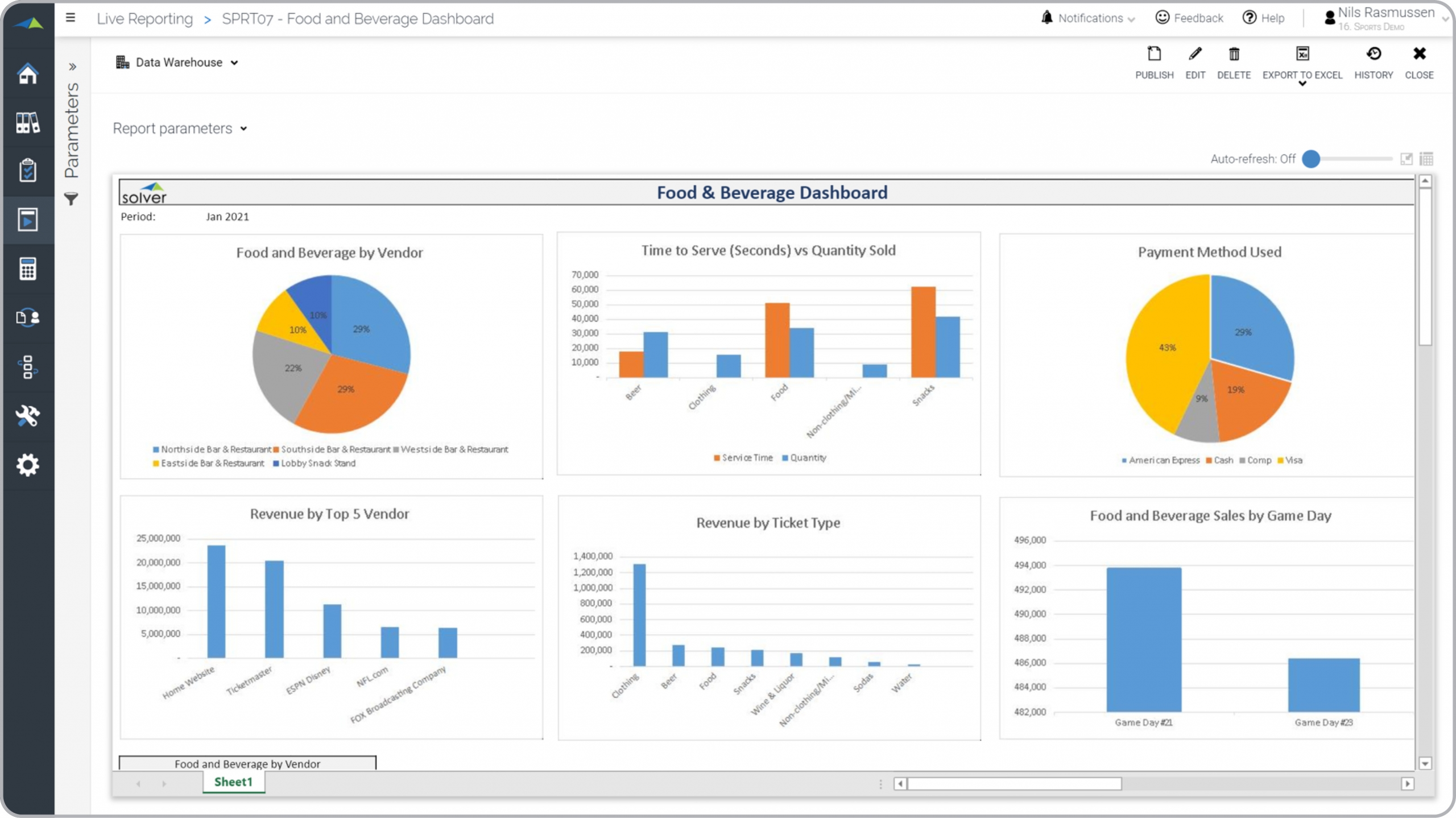Food and Beverage Sales Dashboard for Venues and Professional Sports Teams
What is a
Food and Beverage Sales Dashboard
? Food & Beverage (F&B) Sales Dashboards are considered revenue analysis tools and are used by venue managers and financial managers to monitor key sales metrics related to F&B revenues from venues and events/games. Some of the main functionality in this type of dashboard is that it displays charts focused on vendors, food and beverage categories, payments and service level. Information includes: 1) Each vendor's percent of total F&B sales, 2) Time to serve versus quantity sold, 3) Payment methods used, 4) Sales ranked by vendors, 5) Revenue ranked by F&B category, and 6) F&B sales by event/game. You find an example of this type of dashboard below.
Purpose of
Food and Beverage Sales Dashboards Sports organizations use Food and Beverage Sales Dashboards to give managers a clear view of F&B performance metrics. When used as part of good business practices in Financial Planning & Analysis (FP&A) departments, a company can improve its revenues and optimize decisions related to venue restaurants, and it can reduce the chances that poor performing vendors and F&B categories lead to sub-optimized sales.
Example of a
Food and Beverage Sales Dashboard Here is an example of a F&B sales dashboard with vendor, item and payment analysis. [caption id="" align="alignnone" width="2560"]
 Example of a Food and Beverage Sales Dashboard for Venues and professional sports teams[/caption] You can find hundreds of additional examples
here
Who Uses This Type of
Dashboard
? The typical users of this type of dashboard are: Revenue managers, financial executives, venue managers, F&B managers.
Other Reports Often Used in Conjunction with
Food and Beverage Sales Dashboards Progressive Financial Planning & Analysis (FP&A) departments sometimes use several different Food and Beverage Sales Dashboards, along with detailed F&B sales reports, profit & loss reports, KPI dashboards, sales budgets and forecasts and other management and control tools.
Where Does the Data for Analysis Originate From? The Actual (historical transactions) data typically comes from enterprise resource planning (ERP) systems like: Microsoft Dynamics 365 (D365) Finance, Microsoft Dynamics 365 Business Central (D365 BC), Microsoft Dynamics AX, Microsoft Dynamics NAV, Microsoft Dynamics GP, Microsoft Dynamics SL, Sage Intacct, Sage 100, Sage 300, Sage 500, Sage X3, SAP Business One, SAP ByDesign, Acumatica, Netsuite and others. In analyses where budgets or forecasts are used, the planning data most often originates from in-house Excel spreadsheet models or from professional corporate performance management (CPM/EPM) solutions.
What Tools are Typically used for Reporting, Planning and Dashboards? Examples of business software used with the data and ERPs mentioned above are:
Example of a Food and Beverage Sales Dashboard for Venues and professional sports teams[/caption] You can find hundreds of additional examples
here
Who Uses This Type of
Dashboard
? The typical users of this type of dashboard are: Revenue managers, financial executives, venue managers, F&B managers.
Other Reports Often Used in Conjunction with
Food and Beverage Sales Dashboards Progressive Financial Planning & Analysis (FP&A) departments sometimes use several different Food and Beverage Sales Dashboards, along with detailed F&B sales reports, profit & loss reports, KPI dashboards, sales budgets and forecasts and other management and control tools.
Where Does the Data for Analysis Originate From? The Actual (historical transactions) data typically comes from enterprise resource planning (ERP) systems like: Microsoft Dynamics 365 (D365) Finance, Microsoft Dynamics 365 Business Central (D365 BC), Microsoft Dynamics AX, Microsoft Dynamics NAV, Microsoft Dynamics GP, Microsoft Dynamics SL, Sage Intacct, Sage 100, Sage 300, Sage 500, Sage X3, SAP Business One, SAP ByDesign, Acumatica, Netsuite and others. In analyses where budgets or forecasts are used, the planning data most often originates from in-house Excel spreadsheet models or from professional corporate performance management (CPM/EPM) solutions.
What Tools are Typically used for Reporting, Planning and Dashboards? Examples of business software used with the data and ERPs mentioned above are:
- Native ERP report writers and query tools
- Spreadsheets (for example Microsoft Excel)
- Corporate Performance Management (CPM) tools (for example Solver)
- Dashboards (for example Microsoft Power BI and Tableau)
Corporate Performance Management (CPM) Cloud Solutions and More Examples
June 22, 2021
TAGS:
Reporting,
Solver,
NPSL,
report writer,
Microsoft,
NBA,
template,
practice,
Acumatica,
basketball,
league,
f&b,
MLB,
Netsuite,
Finance,
planning,
GP,
dashboard,
Business Central,
excel,
professional,
ax,
Sports,
forecast,
Budget,
Dynamics 365,
budgeting,
professional sports,
revenue,
Cloud,
Software,
Tableau,
SAP,
NRL,
example,
NHL,
NFL,
best,
Sage,
BC,
EPL,
D365,
MLS,
NAV,
Intacct,
soccer,
hockey,
baseball,
CPM,
report,
SL,
Management,
dynamics,
football,
Power BI,
game,
food and beverage dashboard,
food and beverage sales

